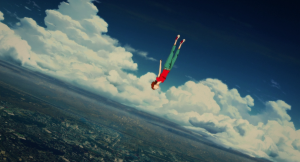Satoshi Kon – Depicting Duality
A constant struggle in most of our lives is duality. Whilst we very much like things to be cleanly distinct and singular, the fact is that life is a process of constant change and evolution, and exists in a myriad of different elaborate contexts. We are constantly becoming someone new and even within the person we may perceive ourselves to be on any given day we change dramatically to align ourselves appropriately in the environments we enter into.
Our story telling process is often stuck within language, something that defines the world as a neat and unchanging place. Take your name for example. You will live out an entire life of change but linguistically, your identity remains within those few letters. This is an issue when we attempt to divulge, within a narrative, how identity is more pliant, suggestible, and compromising than that. Things rarely attain to a single state of existence yet they will hold a single name… Whilst this poses a definite narrative struggle I think that visual media gives us our best hope at explaining this duality. Language often traps us within singularity, but imagery can express interactions that are unblemished by linguistic interpretation.
Satoshi Kon’s work in the field of animation is a perfect example of this. Within his career he completed four films and a television series the majority of which focused upon how we cope with leading multiple lives. Rather than explain these interactions of the self within the script he used a process of editing to visually link information together. He would show one person existing in a multitude of ways, using matching scene transitions to draw out, from a single character, this distinct complexity.
My favourite example of this is his 2006 film Paprika which follows the concept of our waking selves vs. our dreaming selves. In the first 4 minutes of the film there are 5 different dream sequences all connected by match cuts. The settings the characters appear in are malleable and exists almost purely to reflect the dynamic reactions of the characters as different events, interactions and environments test the elasticity of their identity. Every character within this film has their identity tested in this manner but the most cohesive and comprehensive example of this theme of elasticity is the main character Doctor Atsuko Chiba and her alter-ego Paprika. Chiba is a detached all-be focused woman dedicated to the creation of the “DC Mini”, a device that lets us see into, and enter, other peoples dreams. Whilst she is controlled and inexpressive when awake, Paprika, her dream alter-ego is vibrant, risk-taking and engaging.
Unlike the other characters in the film Chiba actively converses with Paprika on multiple occasions as their visual identities fluctuate in and out of singularity. The two are both seperate and the same which is conveyed through match cuts and quirky transitions, alongside parallel depictions in which Paprika exists as Chiba’s reflection. The two represent the people that Chiba allows herself to be at any given time. In her professional life she feels the need to be reserved and professional, but within dreams she allows herself freedom and risk; the two are not multiple personalities, simply multiple existences of a single person. As these characters interact and intersect we see how a single person can exist in a multitude of different ways.
We do not exist as an external force in our environment as much as we become an element of it. Kon expresses this perfectly within Paprika. His way of connecting each frame to the next expresses the dynamic and interconnected nature of life itself. Everything we encounter moulds us and visa vera, his dynamic visual creations express this. Nothing about this film is static, the characters included. As everything is in constant movement we get a wonderful picture of how a single interaction cannot express a complete picture of our complex human identities.
We are flawed, susceptible and pliant which is possibly the best attribute we have as human-beings. We are not one thing, but a plethora of different, ever-changing attributes and actions in a constant process of recreation and rebirth. Kon’s visual fabrications exemplify this to a breathtakingly beautiful extent as his use of match cuts and dynamic settings allow his characters to become far more complex than his two-dimensional illustration of them. Kon’s animation allows for a look into human complexity rarely depicted within film and his work within the field of animation is sorely missed because of it.

